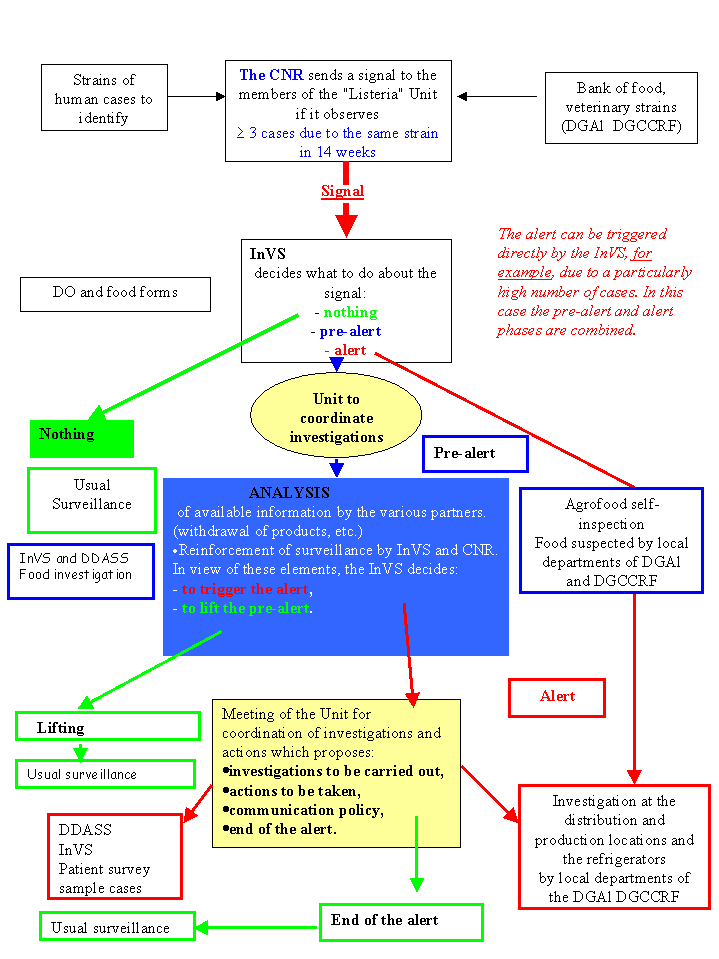

Pan-European Conference on Food Safety and Quality
Budapest, Hungary, 25 – 28 February 2002
Conference Room Document
Coordination of public health,
veterinary and consumer networks
Example of the "Listeria" Unit
Delegation of France
Listeriosis is monitored in France via the Déclaration Obligatoire (DO Mandatory Notification1) and the Centre National de Référence (National Reference Center CNR) of Listeria, at the Listeria Laboratory of the Institut Pasteur, which centralises and defines the strains de L. monocytogenes from microbiology laboratories. The DO enables the physician of the Direction Départementale des Affaires Sanitaires and Sociales (Health Local Authority DDASS) to gather early information on the food consumption of patients during the 2 months preceding the symptoms.
Signalement and "pre-alert" phase
When the CNR detects or identifies, at least 3 cases due to an "identical" strain (strain with the same DNA profile), among strains isolated in humans, over a period of 14 weeks, it informs the members of the "Listeria Unit" by e-mail. The CNR has also a data-base of strains of food origin, created from strains sent for typing by veterinary and food hygiene laboratories.
The Institut de veille sanitaire (InVS), under the aegis of the Direction générale de la santé (DGS, Department of the Ministry of Health) analyses information on patients (DO sheets and food forms) and decides, on the basis of elements suggesting the existence of a common source of contamination, to move to the pre-alert phase.
In this pre-alert phase:
- the CNR accelerates analysis of results concerning human strains and creates a history of the strain (human cases). It also seeks, among the food strains of the previous 6 months, those which show the profile of the pre-alert;
- the Direction générale de l’alimentation (DGAl Department of the Ministry of Agriculture) and the Direction générale de la concurrence de la consommation and de la répression des fraudes (DGCCRF Department of the Ministry of Economy), according to the information transmitted by the InVS on the consumption of patients, analyse the available information (checks, withdrawals of products, etc) ensuring, if necessary, transmission to the CNR of listeria, of certain strains isolated in production or distribution. They also seek the origin of food strains with the profile of the pre-alert, which may already have been detected by the CNR.
It may be that the InVS, notably in view of all the available information, decides to trigger the alert immediately without a pre-alert phase.
Triggering of the alert leads to activation of the "listeria Unit" responsible for coordinating investigations and actions. This Unit consists of representatives of the DGS, InVS, DGAl, DGCCRF and CNR of Listeria. If necessary it can seek the assistance of experts. Within the Unit, the role of InVS and CNR of Listeria entails technical support and aid in decision-making.
Alert phase:
- When the alert is triggered, local services are informed by their respective administrations. They are reminded of the information circuit in times of alert, in particular, the need to send the bacterial strains urgently to the CNR of listeria and send the food forms rapidly to the InVS.
- The various partners of the coordination Unit decide on the investigations to be made in order to identify any common food at the origin of these cases and avoid new cases by implementing appropriate measures. In all cases this Unit defines, the communication which will be made to the administrative departments concerned. This communication complies with the communication protocol, established in May 2000, in the event of non-conformity of a food vis à vis Listeria monocytogenes.
- In the framework of regulatory obligations, communication to professionals, the relevant authorities in other countries, European surveillance networks is at the initiative and under the responsibility of each structure of the Unit according to their own roles. The other members of the Unit are kept informed of the information transmitted in this context.
- The co-ordination Unit also evaluates the end of the epidemic and proposes the lifting of the alert. The alert may be maintained for some time after the epidemic (important information in particular for local State departments and for the CNR which only resumes routine procedure for strains when the alert is officially ended).
DIAGRAM OF A "LISTERIA" ALERT
 |
1 The DO system was put in place progressively during the 2nd quarter of 1998 by Decree n°98-69 of 13 March 1998